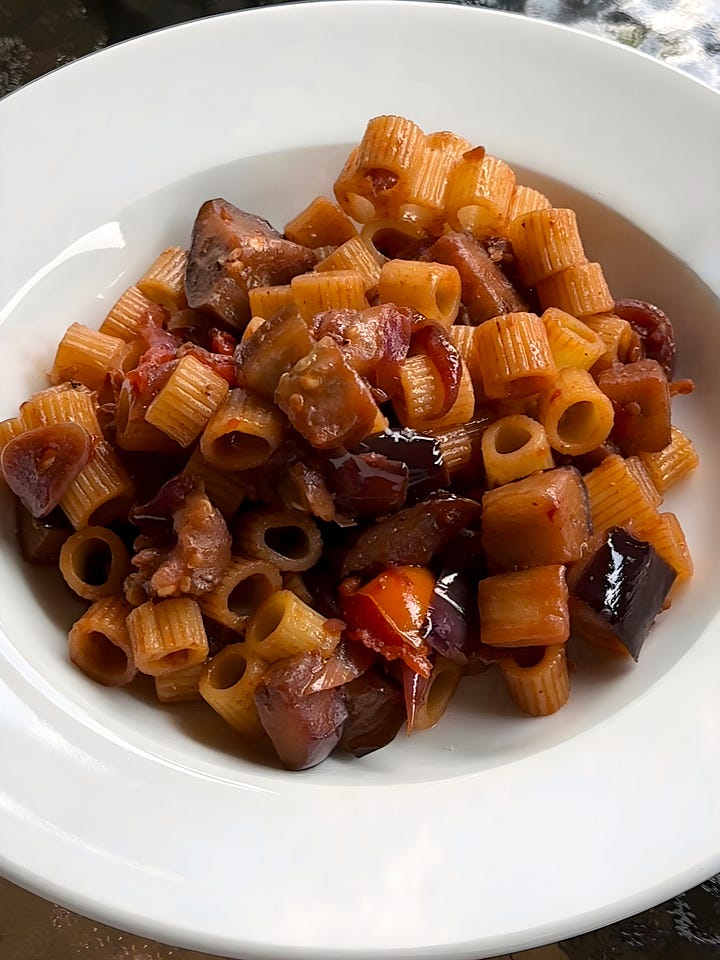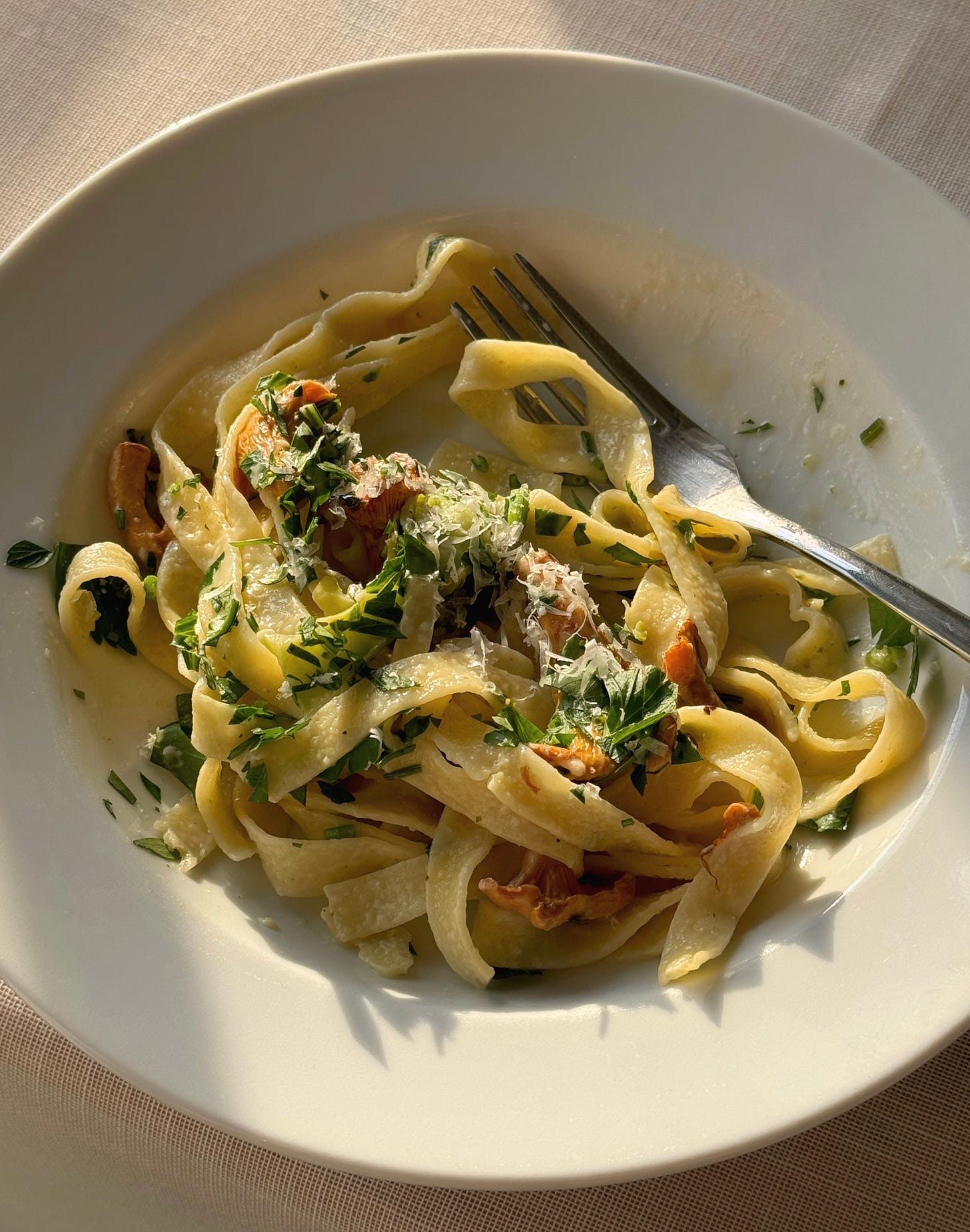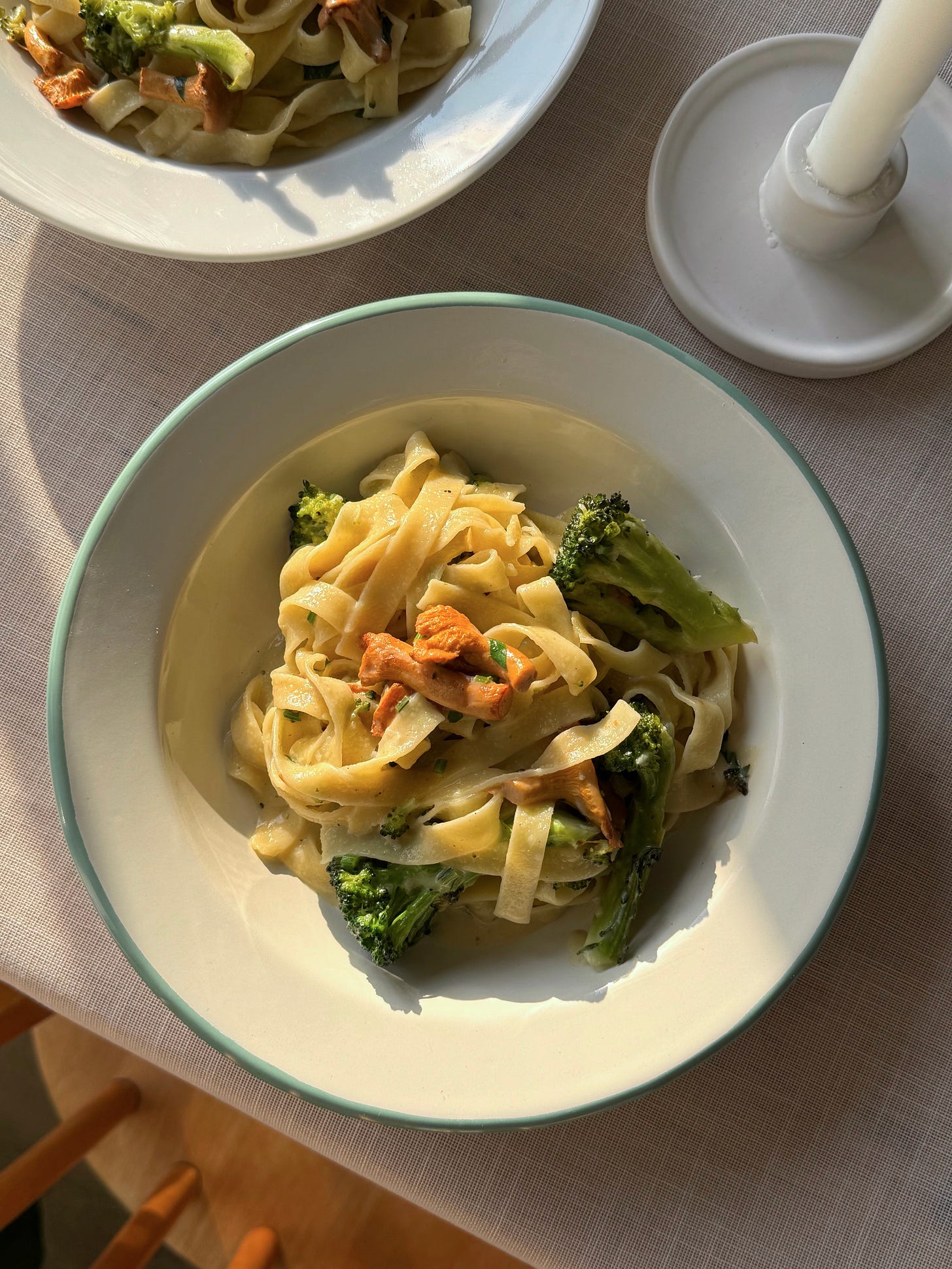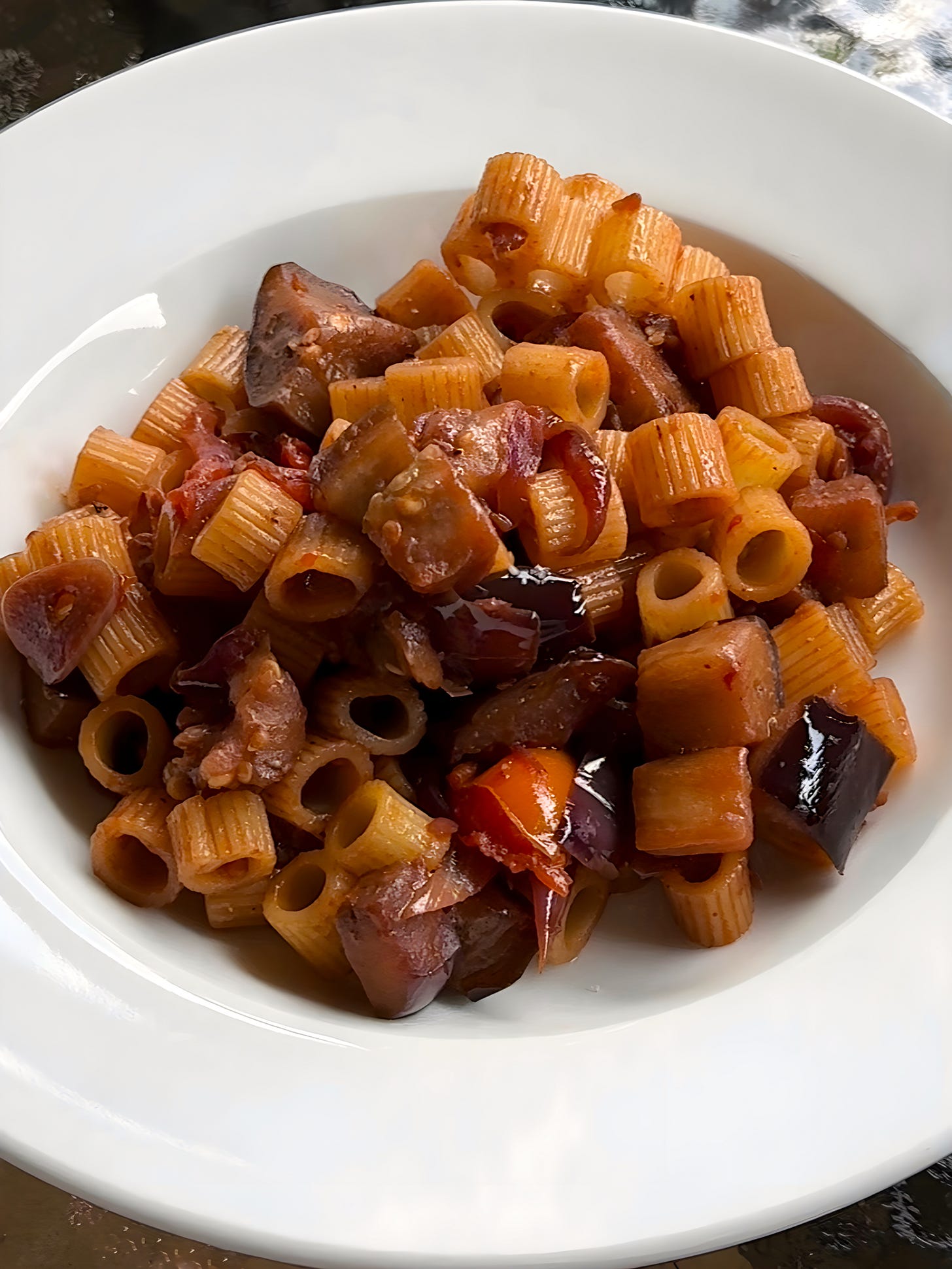Allô! 👋
Welcome (back) to seasonal sundays, the supplement to good food at home where we take a closer peek at produce at its peak — with a short introduction, at least one recipe, and a (sometimes related) cooking Q&A. If you’d like to help the newsletter grow, feel free to share this issue using the button below!
Happy Sunday! I hope you’ve all been enjoying these first few days of September.
This week, we’re putting the spotlight on weeknight pastas, via some of the season’s most popular and abundant produce: chanterelles, broccoli, corn, zucchini, eggplant, and tomatoes — that’s right, we’re talking fruit, vegetables, and fungi. (I wasn’t kidding last week when I said I was eating pasta on repeat!)
On today’s newsletter menu, we’ve got an introduction to chanterelles, followed by five weeknight pasta recipes, and, to finish, a quick Q&A on how to store eggplants properly (keeping it short, because, you know, FIVE RECIPES).
Hope you enjoy!
Wishing you a beautiful day and lots of gorgeous meals ahead
— Simone




You probably don’t need me to tell you that we’re currently entering peak mushroom season (and, if like me, you live in a country where mushroom foraging is a thing, then you really don’t need me to tell you that we’re entering peak mushroom season).
The mushroom that most people around here get excited about, especially in September, is the chanterelle — or, to be more specific, the golden chanterelle also known as girolle.
Below are some chanterelles tidbits that could be good to know 🍄:
peak seasonality
Late summer to early fall (though, depending on your region, they can also be found as early as June or as late as December)
where to find them
In farmers’ markets or at farm stands;
in your local deciduous (look in low grass) or coniferous forests (look for mossy areas), if you know your way around mushroom picking (toxic lookalikes exist! make sure you know what you’re doing);
occasionally in supermarkets (although they’re less likely to be freshly picked), and often in specialty grocery stores
shopping / foraging tips
Look for firm, even-hued mushrooms with no signs of slime, mould, or any large uneven areas that are dark, damaged, or dried-out. Ideally, your chanterelles will be fairly clean, although a little forest filth is always to be expected.
storage and shelf-life
Keep in a sealed container or bag, with a clean kitchen cloth or paper towel popped in to trap excess moisture, and store refrigerated. They should keep like this for up to a week, though are best eaten as close to picking as possible.
aroma and taste
Usually has a fruity, pleasant apricot-like smell (though not always; refrigeration will especially dull the smell). The taste is complex and often described as mild and savoury, with fruity, earthy, and nutty notes. The texture itself is pleasantly meaty, with a velvety chew.
uses and preparation
Use as you would other mushrooms, cooking either straight away, frying dry then frying in fat before freezing, or simply pickling, lacto-fermenting, or dehydrating for later.
To prepare, gently brush as much soil off the mushrooms as you can, then give them a quick-but-thorough rinse or soak, making sure to remove any excess moisture by laying them on a clean dishtowel afterwards (though a bit of residual wetness prior to cooking is not only fine, it can actually be desirable with chanterelles).
You can cook them however you like — these are not good raw — although most people would recommend involving garlic, parsley, and butter in some capacity.
Some more detailed than others, below are five pasta dishes I find myself regularly making on late summer weeknights (PDF with all recipes at the bottom):
creamy chanterelle & broccoli tagliatelle 🥦
I know there are chanterelles all around at the moment because people near me keep posting pictures of their foraged finds, but, alas, the golden rule of mushroom picking in Norway (and likely abroad) seems to be: keep your mushroom spots a well-kept secret.
Seeing as I don’t have hours to spend roaming the woods searching for fungeous gold, I’ve yet to experience the thrill of picking your own — which may very well be for the best, seeing as not all chanterelles are safe to eat, and I know very little about mushroom picking. Luckily for me, one of the farm shops in my area also sells foraged ingredients from time to time, so every late summer I get to sample some local mushrooms and support my local farmers all in one go.
I normally only make the pasta below with girolles, but this year the farm’s broccoli was looking too good to use just as a side, so I decided to add some in. The result? A big, delicious, win. (If you want to enjoy it broccoli-free, however, you are welcome to simply omit the brocc’ and double up on the mushrooms.)
CREAMY CHANTERELLE & BROCCOLI TAGLIATELLE
serves two
INGREDIENTS
• 125-150g chanterelles
• 150g / roughly half a head broccoli
• 10g / 4 cloves garlic
• 5g / 1 very small bunch fresh parsley leaves and stems
• 40g / a large pat butter salted
• 140-175g long fat pasta such as tagliatelle, fettuccine, or pappardelle*
• 3g / 5ml / 1 tsp flour
• 50g heavy cream
• 90ml vegetable or chicken stock†
• 25ml / a splash white wine or dry vermouth
• sea salt
• freshly cracked black pepper
• (optional) extra virgin olive oil + Parmesan
*use 175g for large portions, 140g for “regular”/medium ones
†feel free to use just-boiled water with a ¼ stock cube and a pinch of salt dissolved into it instead
METHOD
1. Brush any loose dirt off 125-150g of chanterelles, then rinse or soak them to clean them well. Place the cleaned mushrooms in a dishtowel-lined colander to dry a little while you peel and microplane (or finely mince) four cloves (10 grams) of garlic, finely slice the stems from a small bundle (5 grams) of parsley, and cut half a head of broccoli (approx. 150g) into smaller pieces. Pat the chanterelles dry.
2. Place a large heavy-bottomed pan over medium-to-medium-high heat, and put a large pot of water to boil for your pasta. Melt a large pat (40 grams) of butter in the pan and, once it’s all pale and foamy, slide in all of the broccoli chunks. Stir them around regularly. Meanwhile, season the pasta water with salt and add enough pasta for two (140 to 175 grams) to the pot — cook until almost al dente. As soon as the broccoli is a vivid green colour on all sides, add in the chanterelles. Stir them around well, then, once any excess water has fried off, add the minced garlic and chopped parsley stems to the pan. Stir again, and keep frying everything in the butter for a couple of minutes more, until the chanterelles are vividly golden and their edges have browned from frying in the fat.
3. Add a small splash (25ml) of white wine or dry vermouth to the pan then, once it has evaporated, evenly sprinkle over a pinch of flour (3 grams / 5 millilitres / 1 teaspoon). Pour in a small amount (90 millilitres) of stock and a good splash of cream (50 grams), then stir everything well. Finely chop the parsley leaves.
4. Transfer the almost al dente pasta straight from the pot to the pan, and finish cooking it in the brothy cream, tossing regularly.
5. Turn off the heat, sprinkle about a quarter of the chopped parsley leaves into the pasta and crack some black pepper over top. Serve straight away, then garnish each plate evenly with the rest of the parsley. If you like, you can also top each plate with a really fine drizzle of olive oil, as well as freshly grated Parmesan.
pasta two
eggplant, red onion, and tomato pasta 🍆🍷
I always keep wine in my fridge — not for drinking, but for cooking.
Here’s how to make the red wine infused eggplant, red onion, and tomato pasta pictured above:
(serves 3 people in theory, but 2 people who can’t resist seconds in practice)
INGREDIENTS
Keep reading with a 7-day free trial
Subscribe to good food at home to keep reading this post and get 7 days of free access to the full post archives.











